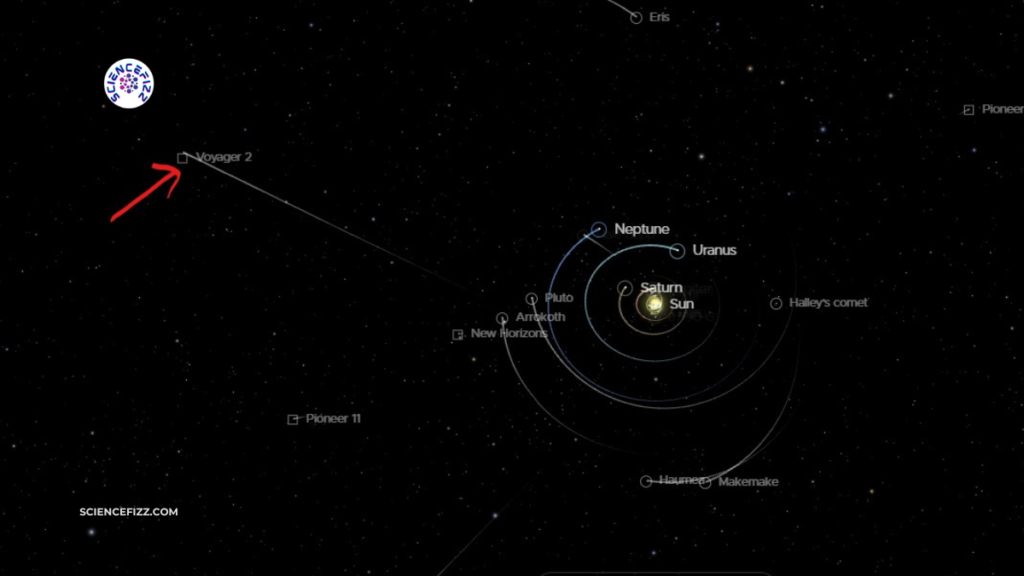NASA has planned to extend the mission of its iconic 45-year-old Voyager 2 mission spacecraft. Thus Voyager-2 will keep functioning till 2026 outside our Solar System.
NASA’s Voyager 2 spacecraft has just received an extra lease of life after mission engineers developed a new plan to keep its instruments running for a longer period.
The Voyager 2 probe is still traveling in interstellar space and is the only spacecraft that has ever operated outside the heliosphere. It was launched over 45 years ago in 1977.
In this article, we will discuss how the Voyager 2 probe is getting an additional lease of life and why it is important for the scientific community.
Understanding Voyager 2 Mission
Voyager 2’s Journey
Voyager 2 was launched in 1977 and was designed to explore the outer planets of our solar system, namely Jupiter, Saturn, Uranus, and Neptune.
The spacecraft continued its journey to the edge of the heliosphere, after completing its mission, where interstellar space begins.
Currently, the spacecraft is more than 20 billion kilometers away from Earth and is still sending back valuable scientific data.
Read Also: James Webb Telescope Captures The New Insights Of Uranus
The Heliosphere
The heliosphere is a bubble of particles and magnetic fields generated by the Sun. It is considered to be the border of our solar system, beyond which lies interstellar space.
Voyager 2 and Voyager 1 are the only spacecraft that has ever operated outside the heliosphere, and their mission is to help scientists better understand the heliosphere and how it protects our planet from interstellar energetic particles and other radiation.
Power Sources
Both Voyager 1 and Voyager 2 are powered by radioisotope thermoelectric generators (RTGs) or “nuclear batteries.” These nuclear batteries convert the heat from decaying plutonium into electricity.
Since the plutonium is continuously decaying, it means that the generator produces less and less power as time goes on.
The declining power supply has not impacted the mission’s science objectives so far, as engineers have turned off heaters and other non-essential systems to keep the probes going.
Voyager 2 Gets a New Lease of Life
Power-Saving Measures for Voyager 2
The declining power supply has become a cause of concern for mission engineers as Voyager 2 was scheduled to shut down its science instruments this year.
However, a new plan was developed to keep the instruments working by using a small reservoir of backup power that was set aside as part of an onboard safety mechanism.
This backup power will enable the spacecraft to continue operating its science instruments until 2026, which is four years longer than previously anticipated.
Importance of the Voyager Mission
The Voyager mission has provided valuable information about our solar system, and the scientific data that the Voyagers are returning is getting more valuable the farther away from the Sun they go.
Therefore, scientists are interested in keeping as many science instruments operating as long as possible.
The Voyager 2 spacecraft is helping scientists better understand the heliosphere and how it protects our planet from interstellar energetic particles and other radiation.
Future Plans
Now that Voyager 2 has been given a new lease of life, NASA’s Jet Propulsion Laboratory (JPL) plans to keep the spacecraft’s science instruments turned on for a few years longer than previously anticipated.
This will allow scientists to gather more data and continue their research on the heliosphere and interstellar space.
Conclusion: NASA’s Voyager 2 Mission
The Voyager 2 probe has received an extended period of life, thanks to a new plan developed by mission engineers to keep its instruments working despite a reduced power supply.
The Voyager mission has provided valuable information about our solar system and interstellar space, and scientists are interested in keeping as many science instruments operating as long as possible.
Voyager 2 will continue to provide valuable data until 2026 with the new plan.
